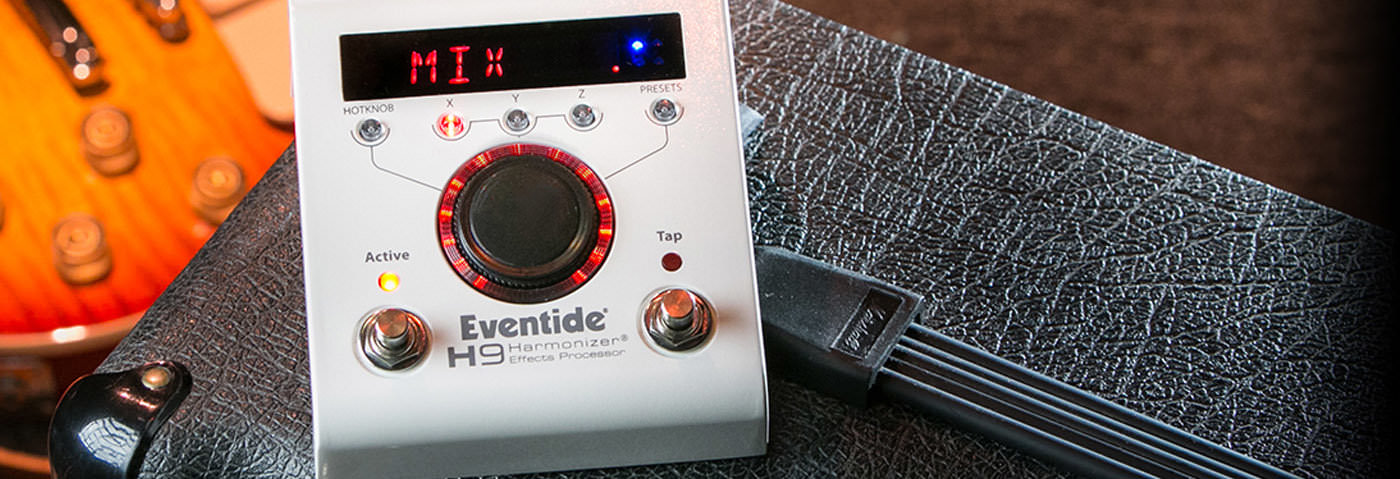Greg Scarth puts forward the case for hardware effect units, showing how the Eventide H9 can be used as a creative tool.
Digital effects have now become so dominant that we take them for granted, but it wasn’t always like this. For those who aren’t familiar with the Eventide brand name, an abridged history goes something like this: formed in 1971 in Little Ferry, New Jersey, Eventide became one of the key players in the development of early digital signal processing hardware. The company’s H910 Harmonizer rack-mount unit was the world’s first commercially available digital effects processor. Released in 1975, it revolutionised the studio world.
Four decades on, the way we view digital effects has changed immeasurably. At the very best they’re now taken for granted. At worst, they’re even considered unfashionable in a world obsessed with retro analogue gear.
The way we view digital effects has changed immeasurably. At the very best they’re now taken for granted. At worst, they’re even considered unfashionable in a world obsessed with retro analogue gear.
Eventide themselves continue to make hardware effects units, but a lot has changed since the H910. As much as we admire the powerful rack-mount processors in the current Eventide range, they aren’t cheap. We definitely wouldn’t say no to the flagship H8000FW, but the prices are likely to be out of reach for most producers. For a cheaper option, turn to the company’s stomp boxes instead. Units like the TimeFactor and Space released in 2008, or the more recent H9, offer excellent value for money, with a number of their algorithms derived from much more expensive units.
So what does a hardware effect unit offer that software doesn’t in 2016? For a start, the processing power of a good DSP platform is not to be underestimated. Secondly, there’s no load on your CPU, there’s almost no latency and it’s easy to integrate a hardware unit with other hardware.
There's almost no latency and it's easy to integrate a hardware unit with other hardware.
Perhaps most importantly of all, most hardware effects also offer real-time hands-on control. In the case of the H9 that’s admittedly a little limited, with just one ‘hot knob’ to control parameters, but there are also options to use a MIDI controller, an expression pedal or an excellent iOS app with touchscreen control of all parameters. Dial in a delay time by hand and you’ll understand just how important the hands-on factor is; the imprecision of a manually-set delay time is part of the appeal of those classic delay sounds we all love. Yes, you can do that in a delay plugin with a MIDI controller, but be honest: how often do you do it? Most of us are so used to tempo-synced delays that we tend to use them without questioning whether manual timing would be better.
Delay effects are sometimes unfairly dismissed as being dull, but there are very good reasons why most professional studios still feature a couple of good hardware reverbs and delay units. To demonstrate the creative potential, let’s see how we can use the H9 as a tool to generate unorthodox drum patterns and melodic parts.
Let’s start with a simple drum pattern:
(For the sake of clarity, all the clips here are presented in mono with no compression or EQ applied. In practice, you’d usually want to process individual hits further to make them work in a mix.)
Instead of the typical precise, tempo-synced delay, we’ll apply a delay to the snare with the time set manually:
You can immediately hear how the phasing effect of the slightly mistimed snare delays adds an organic texture to the beat:
We can apply a similar effect to a melodic phrase. We’ll start with another simple beat:
Here’s our melody part on its own:
And the same part with delay applied:
Here’s how it sounds when we mix it back into the beat:
Finally, one of the most interesting ways to use delays creatively is to feed in a rhythm, then allow the delay effect to build the beat. Here we start with a very straight drum pattern:
If we solo the closed hi-hat part, you can hear how simple it is:
Adding a delay to that part, we can create the following pattern, which sticks to a straight rhythm but can be coloured to taste using different delay algorithms:
Mix that back into the original beat and we get a much more interesting pattern which can be adjusted to taste:

01.58 PM
Yup I confirm outboard tweakable delays are really fun. I agonised between Eventide (Timefactor ) and Strymon Timeline before settling on a DD500 from Boss. Delays are extremely clear (and deeply programmable) Great with synths, drums etc.
08.06 PM
so good to see people coming back round to hardware fx again. i LOVE the eventide space. amazing tip for anyone on a budget is the ensoniq dp4 (or even dp2) if you can find one. amazing 90s sounds. makes everything sound good
08.07 PM
oh and early alesis midiverbs go for hardly anything
10.06 AM
Anyone knows if you can use more than one fx at the same time with the H9?
05.33 PM
You can not use more than one effect at the same time but the effects of the H9 are often combining several traditional effects in one multi-effects algorithm.